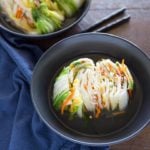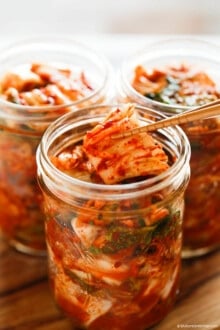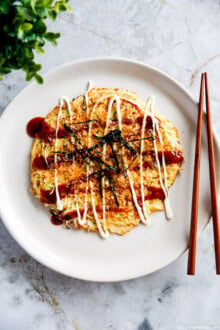White Kimchi (Baek Kimchi) is a non-spicy kimchi variety that tastes mild and refreshing.
It’s particularly popular amongst kids and spicy food cautious people. This recipe is vegan, vegetarian and gluten free friendly.

When you think about kimchi / kimchee (김치) what comes up first in your mind? If nothing comes, how about this: Wickedly spicy looking napa cabbage kimchi!
Well, at least that’s how my daughter thinks of kimchi in general! Lol.
She calls any red kimchi (regular type) “bad kimchi” and white kimchi (Baek Kimchi) “good kimchi”, because it’s not spicy.

As I mentioned already, Baek Kimchi (백김치, 白泡菜) means white kimchi. Unlike regular kimchi (spicy kinds) made with Korean chili flakes (gochugaru), Baek Kimchi doesn’t use any chili flakes. Instead, it is submerged in fruity salty brine.
This is a very important sauce as white kimchi’s flavour depends on it. Some people add fish sauce and flour like you normally would when making regular kimchi, but I made mine without these. So you can appreciate the simplicity and the individual flavour even more!
Another notable difference between the white kimchi and regular kimchi is that white kimchi is often stuffed with some fancy ingredients such as pine nuts, dried jujubes and chestnuts etc.
While minimal, these ingredients do add subtle luxurious flavours to the kimchi, so I suggest you don’t leave them out if you can!
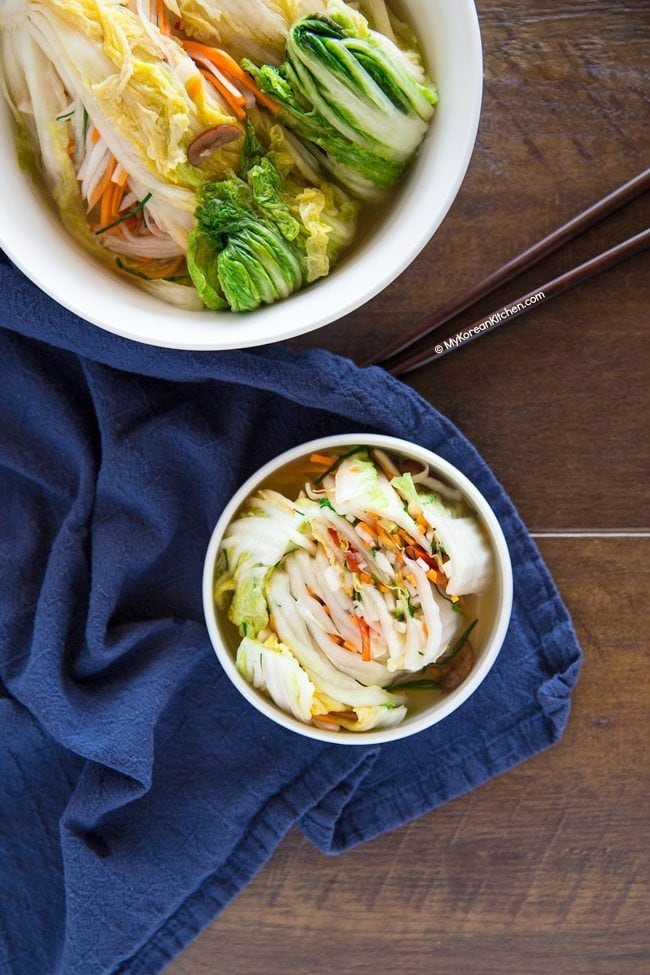
White kimchi is mild and refreshing. It goes well with any Korean dishes, but it particularly goes well with Korean char-grilled BBQ. Just thinking about this combo make my mouth water. Mmmmm
It’s very easy to make (4 simple steps!) and friendly to your stomach, so I hope you give it a try soon!
PS. Here are my other kimchi recipes, you might like to try. Radish Kimchi (Kkakdugi) and Kimchi Salad (Baechu Geotjeori)
Ingredients for Non-Spicy White Kimchi (Baek Kimchi)
Pickled Kimchi
- 1 large napa cabbage (1.6 kg / 3.5 pounds)
- 1/4 cup coarse sea salt
- Pickling brine (Combine these two. Salt should be mostly dissolved prior to use)
- 3/4 cups coarse sea salt
- 4 cups water
Kimchi fillings
- 1/2 carrot (100g / 3.5 ounces), julienned
- 200g / 7 ounces Korean radish or daikon radish, julienned
- 20g / 0.7 ounces asian chives, chopped in little finger lengths
- 30g / 1 ounce red bell pepper, julienned
- 4 fitted dried jujube (10g / 0.4 ounces), thinly sliced
- 1 Tbsp pine nuts
Kimchi brine
- 4 cups water
- 1 Tbsp coarse sea salt
- 300g / 0.7 pounds Korean pear or bosc pear, peeled and seeded
- 150g / 5.3 ounces red apple, peeled and seeded
- 50g / 1.8 ounces onion, peeled
- 1 Tbsp minced garlic
- 1 tsp minced ginger
*1 Tbsp = 15 ml, 1 Cup = 250 ml
**If you want to learn more about Korean ingredients, check my 30 essential Korean cooking ingredients list!
How to Make White Kimchi (Baek Kimchi)
1. Cut the cabbage into half then quadrants. Sprinkle the salt directly on the white part of the cabbage and pour the pickling brine onto the cabbage. Place a heavy object (e.g. a large salad bowl full of water) onto the cabbage to stop the cabbage floating and to help with the pickling process. Leave it at room temperature until the white part of the cabbage is flexible (for about 1 hour 30 mins). During this time turn the cabbage over a few times to change the position (e.g. every 30 mins). Rinse the cabbage a few times in running water. Rinse off any residue salt. Drain and place on a strainer to drain off the water for 10 to 20 mins.
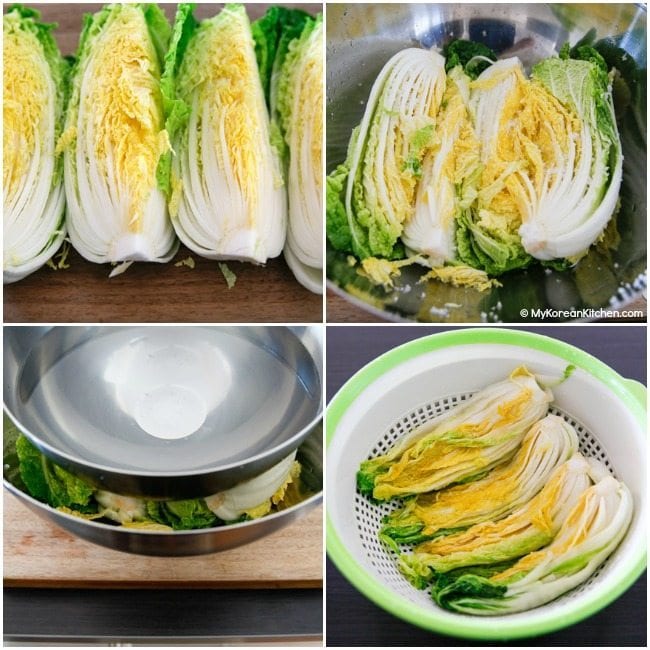
2. Prepare kimchi fillings during step 1 per instruction above (ingredients section). Also, prepare the kimchi brine. Mix the water and salt in a large bowl. Puree Korean pear, apple, onion, garlic and ginger in a blender. Place the blended ingredients into the strainer / cheese cloth and clip the top so that the food content doesn’t come out. Put it into the bowl (salty water from earlier) and soak the strainer / cheese cloth. Squeeze out all the juice from the strainer / cloth to dissolve into the water.
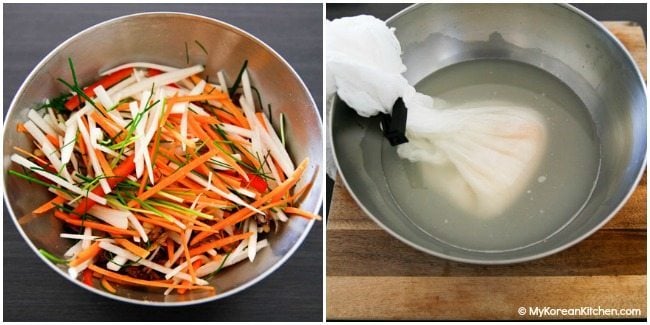
3. Place the pickled cabbage (from step 1) onto a clean board. Starting from the bottom leaves, fill the cabbage with kimchi fillings, evenly, one layer of cabbage at a time. Once done, place the kimchi into a large container, facing down. (I used a 5L container for this recipe.) Repeat this step with the remaining ingredients.

4. Pour the Kimchi brine (from step 2) into the kimchi container. Place a heavy stone or a plate on top to stop the kimchi floating and submerge the kimchi well in the brine. Close the lid. Leave at room temperature for 12 hrs (in summer) / 24 hrs (in winter) then transfer it to the fridge.
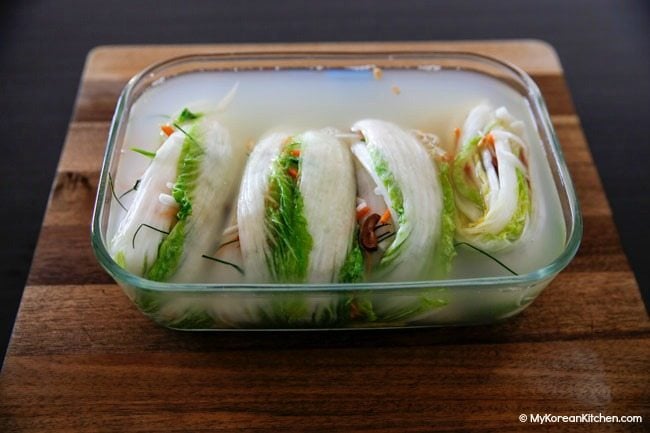
5. You can start serving the kimchi from about day 3. Though it tastes better as it ages (from about day 7) but before it turns too sour. Cut the kimchi as you need before serving. (I normally cut one whole quadrant slice at a time.) Serve the sliced kimchi on a plate and add a few scoops of the kimchi brine on top of the kimchi.
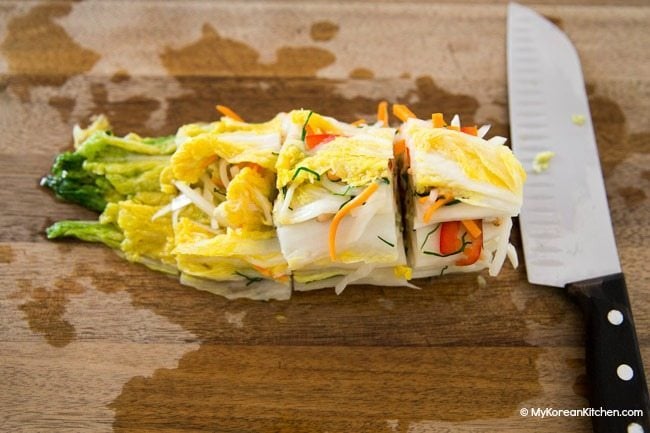
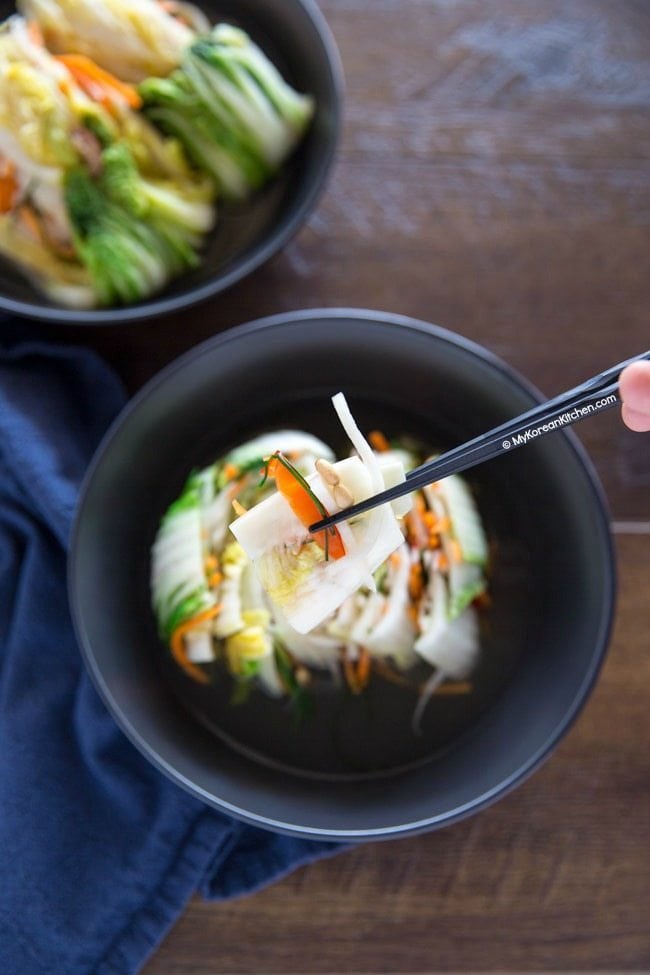
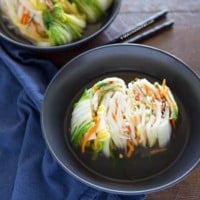
Non-Spicy White Kimchi (Baek Kimchi)
Ingredients
PICKLED KIMCHI
- 1 large napa cabbage (1.6 kg / 3.5 pounds)
- 1/4 cup coarse sea salt
Pickling brine (Combine these two. Salt should be mostly dissolved prior to use)
- 3/4 cups coarse sea salt
- 4 cups water
KIMCHI FILLINGS
- 1/2 carrots (100g / 3.5 ounces), julienned
- 200 g Korean radish or daikon radish (7 ounces), julienned
- 20 g asian chives (0.7 ounces), chopped in little finger lengths
- 30 g red bell pepper (1 ounce), julienned
- 4 pitted dried jujube (10 g / 0.4 ounces), thinly sliced
- 1 Tbsp pine nuts
KIMCHI BRINE
- 4 cups water
- 1 Tbsp coarse sea salt
- 300 g Korean pear or bosc pear (0.7 pounds), peeled and seeded
- 150 g red apple (5.3 ounces), peeled and seeded
- 50 g onion (1.8 ounces), peeled
- 1 Tbsp minced garlic
- 1 tsp minced ginger
Instructions
- Cut the cabbage into half then quadrants. Sprinkle the salt directly on the white part of the cabbage and pour the pickling brine onto the cabbage. Place a heavy object (e.g. a large salad bowl full of water) onto the cabbage to stop the cabbage floating and to help with the pickling process. Leave it at room temperature until the white part of the cabbage is flexible (for about 1 hour 30 mins). During this time turn the cabbage over a few times to change the position (e.g. every 30 mins). Rinse the cabbage a few times in running water. Rinse off any residue salt. Drain and place on a strainer to drain off the water for 10 to 20 mins.
- Prepare kimchi fillings during step 1 per instruction above (ingredients section). Also, prepare the kimchi brine. Mix the water and salt in a large bowl. Puree Korean pear, apple, onion, garlic and ginger in a blender. Place the blended ingredients into the strainer / cheese cloth and clip the top so that the food content doesn’t come out. Put it into the bowl (salty water from earlier) and soak the strainer / cheese cloth. Squeeze out all the juice from the strainer / cloth to dissolve into the water.
- Place the pickled cabbage (from step 1) onto a clean board. Starting from the bottom leaves, fill the cabbage with kimchi fillings, evenly, one layer of cabbage at a time. Once done, place the kimchi into a large container, facing down. (I used a 5L container for this recipe.) Repeat this step with the remaining ingredients.
- Pour the Kimchi brine (from step 2) into the kimchi container. Place a heavy stone or a plate on top to stop the kimchi floating and submerge the kimchi well in the brine. Close the lid. Leave at room temperature for 12 hrs (in summer) / 24 hrs (in winter) then transfer it to the fridge.
- You can start serving the kimchi from about day 3. Though it tastes better as it ages (from about day 7) but before it turns too sour. Cut the kimchi as you need before serving. (I normally cut one whole quadrant slice at a time.) Serve the sliced kimchi on a plate and add a few scoops of the kimchi brine on top of the kimchi.
Notes
Nutrition Info (per serving)
The nutrition information shown is an estimate provided by an online nutrition calculator. It should not be considered a substitute for a professional nutritionist’s advice.
